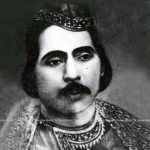Munshi Ameer Ahmad Minai
The Pinnacle of Paeans
Awadh (1722-1856) period paved the way to register in the form of composite culture. This period is also known as golden period of Urdu poetry. Among many of the writers Munshi Ameer Ahmad Minai is considered as one of the most prolific writers of Urdu language. He is best known for his ghazals and popularized the naat genre in Urdu poetry, the popularity of his naats proved to be a trendsetter among other poets. About his early life he was born in 1828 in Post Mughal India. His pen name was ‘Ameer’, and was a popular and cherished poet of his age. He was praised and admired even by his contemporary poets like Ghalib and Daag Dehalvi. He also wrote lines which describes duality in his name and it is:
“Naam ka naam takhallus ka takhallus hai ameer
Aik yeh vasf-e khudaabad mere naam mein hae”
It means – it serves both as my name and my nom de plume /this is a god given feature of my name
Ameer’s father and forefather was descendant of Hazrat Maqdoom Shah Mina and they lived in Lucknow for centuries in the area around Shah Mina’s tomb. Ameer received his education from Firangi Mahal. After needful education as a part of tradition Ameer started learning where about of poetry from an established poet of his time, whom he chose his mentor and his name was Muzaffar Ali Aseer who is also known as “Asar Lukhnavi”. At an age of 24 he became an established poet. Though he was a mystic by training and temperament by family background. His poetry is pulsating with physical charm and gives us glimpses of ecstatic beauty. In his poetry there exist a sharp awareness and engagement with physical world.
He joined the Royal court of Awadh and was appointed to a position of high responsibility in the judiciary but after the attack of 1856 on Lucknow he moved to Kakori and then to Rampur where he held high positions in the judiciary. He was also appointed as the head of Rampur’s magnificent library. In 1900 he moved to Deccan (which is now known as Hyderabad) to seek financial assistance for the publication of his comprehensive multi volume Urdu dictionary “Ameer-ul-Lughaat”. The best period of Minai’s life was 1859-87 at Rampur. It was a period of fulfillment not only materially but in the matter of literary reputation.
“Maratul Ghaib” is the first collection of poetry by the poet. “Minai Sukhan” is another Diwan (collection of poetry) by poet.
One of the famous ghazal of Ameer is
“Haalaat Maikade Ke
Karwat Badal Rahe Hain”
Another famous ghazal which reminds us about his style of writing and it is sung by Late Jagjeet Singh is
“Sarakti jaye hai rukh se naqaab, ahista ahista.
Nikaltaa aa raha hai aftaab, ahista ahista.Sarakti jaye hai rukh se naqaab, ahista ahista.
Jawaan hone lage jab woh, toh humse karlia parda.Haya yak lakht aai or shabab, ahista ahista.
Shab-e-furqat ka jaga hoon,Farishto! ab to sone do.
Kabhi fursat me kar lena hisaab, ahista ahista.
Wo be dardi say sarkate ameer, or mai kahu unsay;Huzoor! ahista, ahista, janab! ahista.
Sarakti jaye hai rukh se naqaab, ahista, ahista.”
This one is also famous among people and K.L. Saigal, Ghulam Ali, M. Kalim and others sang it.
“Jab se bulbul tu ne do tinke liye
tootatee hain bijliyaan in ke liyeKaun weeraane mein dekhega bahaar
phool jungle mein khile kin ke liyeSaree duniya ke hain woh mere siwa
main ne duniya chhod dee jin ke liyeWasl ka din aur itna mukhtasir
din gine jaate hain is din ke liyeBaaghbaan kaliyaan hon halke rang ki
bhejnee hain ek kamsin ke liye”
He is also known as a lexicographer, Sufi, scholar, editor, prose writer, translator, and connoisseur of language. He had studied logic, law, geography, mathematics, medicine, history, religion, music, and philosophy and wrote some 50 books in Urdu and Persian. He is also known as having a master of astrology, `ramal`, and `jafar`, the arts of foretelling the future, and wrote two books on them. However many of his books didn’t get published. Among his books are “Subah-e-Azal” and “Shaam-e-Awadh”. After a month of his arrival in Deccan on October 13, 1900 he died. Although he died long ago in the past but through his ghazals and other writings we can still feel him around us.
Satyendra Singh
(Published in The Lucknow Observer, Volume 2 Issue 19, 5th October 2015)




